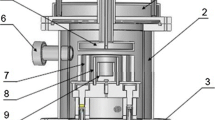Abstract
The activity of components of Sn-Zn binary alloy system was predicted based on the molecular interaction volume model (MIVM). The calculated values are in good agreement with available experimental data of activities, which indicates that this model is of stability and reliability because the MIVM has a good physical basis. The vapor-liquid phase equilibrium of Sn-Zn alloy system in vacuum distillation was calculated as a function of the activity coefficient. The results show that the content of Sn in vapor phase is 4.2×10−7 (mass fraction) while in liquid phase it is 90% (mass fraction) at 1 073 K, and the content of Sn in vapor phase increases with increasing the melt temperature and content of Sn in liquid phase. Vacuum distillation experiments were carried out on Sn-Zn alloy for the proper interpretation of the results of the MIVM in the temperature range of 973–1 273 K under pressures of 15–200 Pa. The experimental results show that the content of Sn in vapor phase is 5×10−6 (mass fraction) while in liquid phase it is 90% (mass fraction) under the operational condition of 1 073 K, 100 min and 15 Pa. The experimental results are in good agreement with the predicted values of the MIVM for Zn-Sn binary alloy system.
Similar content being viewed by others
References
ARI M, SAATÇI B, GÜNDÜZ M, PAYVEREN M, DURMUŞ S. Preparation of high pure zinc for electronic applications using selective evaporation under vacuum [J]. Materials Characterization, 2008, 59: 757–763.
WASEDA Y, ISSIKI M. Purification process and characterization of ultra high purity metals: Application of basic science to metallurgical processing [M]. New York: Springer, 2002, 97.
QIU Ke-qiang, WU Qian, ZHAN Zhi-hua. Vacuum pyrolysis characteristics of waste printed circuit boards epoxy resin and analysis of liquid products [J]. Journal of Central South University: Science and Technology, 2009, 40(5): 1209–1215. (in Chinese)
ALI S T, SRINIVAS RAO K, LAXMAN C, MUNIRATHNAM N R, PRAKASH T L. Preparation of high pure zinc for electronic applications using selective evaporation under vacuum [J]. Separation and Purification Technology, 2012, 85: 178–182.
ALI S T, PRASAD D S, MUNIRATHNAM N R, PRAKASH T L. Purification of tellurium by single-run multiple vacuum distillation technique [J]. Sep Purif Technol, 2005; 43: 263–267.
SHELPAKOVA I R, KOSYNKOV V I, KOVALEVSKI S V, SHESTAKOV V A. The use of evaporation in vacuum purification and analysis of zinc [J]. Mater Res Bull, 1998, 33(2): 173–181.
KOVTUN G P, SHCHERBAN A P, VIRICH V D. Obtaining high purity zinc combining the distillation and crystallization methods [J]. J Kharkiv National University, Physical Series, Nuclei Particles Fields, 2004, 619(1/2/3): 95–104.
GOPALA A, KIPPHARDT H, MATSCHAT R, PANNE U. Process methodology for the small scale production of m6N5 purity zinc using a resistance heated vacuum distillation system [J]. Mater Chem Phys, 2010, 122: 151–155.
YANG Hong-wei, XU Bao-qiang, YANG Bin, MA Wen-hui, TAO Dong-ping. Calculation of phase equilibrium in vacuum distillation by molecular interaction volume model [J]. Fluid Phase Equilibria, 2012, 3: 78–81.
ZHENG Song-sheng, CHEN Wen-hui, CAI Jing, LI Jin-tang, CHEN Chao, LUO Xue-tao. Mass transfer of phosphorus in silicon melts under vacuum induction refining [J]. Metallurgical and Materials Transactions B, 2010, 41B: 1268–1273.
DAI Yong-nian, YANG Bin. Non-ferrous metals and vacuum metallurgy [M]. Beijing: Metallurgical Industry Press, 2000: 40. (in Chinese)
TAO Dong-ping. Prediction of the thermodynamic properities of quaternary liquid alloys by modified coordination equition [J]. Thermochim Acta, 2002, 383: 45–51.
YANG Hong-wei, TAO D P, YANG Xiao-mei, YUAN Qing-mei. Prediction of the formation enthalpies of Bi-Cd-Ga-In-Pb-Sn-Zn liquid alloys by binary infinitely dilute enthalpies [J]. Journal of Alloys and Compounds, 2009, 480: 625–628.
TAO Dong-ping. Prediction of activities of all components in the lead-free solder systems Bi-In-Sn and Bi-In-Sn-Zn [J]. Journal of Alloys and Compounds, 2008, 457: 124–130.
YANG Hong-wei, TAO Dong-ping. Prediction of the mixing enthalpies of the Al-Cu-Ni-Zr quaternary alloys by the molecular interaction volume model [J]. Metallurgical and Materials Transactions A, 2008, 39: 945–949.
TAO Dong-ping. A Comparison of the molecular interaction volume model with the subregular solution model in multicomponent liquid alloys [J]. Metallurgical and Materials Transactions A, 2004, 35: 419–424.
YANG Hong-wei, TAO Dong-ping. Prediction of the mixing enthalpies of binary liquid alloys by molecular interaction volume model [J]. Acta Metallurgica Sinaca, 2008, 21: 336–340.
YANG Hong-wei, TAO Dong-ping, YUAN Qing-mei, YANG Yu. Predicting the formation enthalpies of Cd-Ga-In-Sn-Zn liquid alloys by the limiting partial enthalpies [J]. Fluid Phase Equilibria, 2009, 275: 64–69.
IIDA T, GUTHRIE R I L. Physical properties of liquid metals [M]. Oxford: Clarendon Press, 1988, 19.
FERRO R, SACCONE A. Structure of solids [M] GEROLD V Ed. Weinheim: VCH Verlagasgesellschaft, 1993, 194.
TAO Dong-ping. Prediction of the coordination numbers of liquid metals [J]. Metallurgical and Materials Transactions A, 2005, 36: 3495–3497.
PREDEL B, LANDOLT-BORNSTEIN. Group IV: Physical Chemistry [M]. Vol. 12, Berlin, Heidelberg, New York, Springer, 2006, 20.
HULTGREN R, DESAI P D, HAWKINS D T, GEISER M, KELLEY K K. Selected values of the thermodynamic properties of binary alloys [M]. Metals Park, OH, ASM, 1973, 1268.
Author information
Authors and Affiliations
Corresponding author
Additional information
Foundation item: Project(2012CB722803) supported by the Key Project of National Basic Research and Development Program of China; Project(2011FA008) supported by the Key Project of Science and Technology Program of Yunnan Province, China
Rights and permissions
About this article
Cite this article
Kong, Lx., Yang, B., Li, Yf. et al. Application of molecular interaction volume model in separation of Sn-Zn alloy by vacuum distillation. J. Cent. South Univ. 20, 3372–3378 (2013). https://doi.org/10.1007/s11771-013-1861-8
Received:
Accepted:
Published:
Issue Date:
DOI: https://doi.org/10.1007/s11771-013-1861-8




